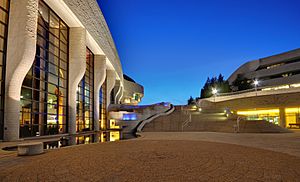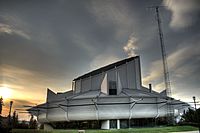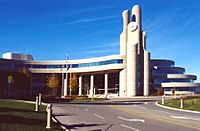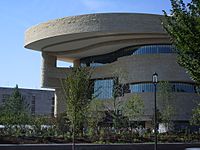Douglas Cardinal facts for kids
Quick facts for kids
Douglas Cardinal
|
|
|---|---|
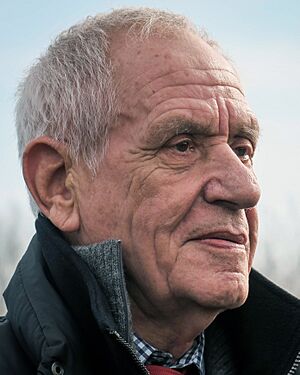
Cardinal in 2016
|
|
| Born |
Douglas Joseph Cardinal
7 March 1934 Calgary, Alberta, Canada
|
| Alma mater | |
| Occupation | Architect |
| Awards |
|
| Projects |
|
Douglas Joseph Cardinal (born March 7, 1934) is a famous Canadian architect. He lives in Ottawa, Ontario. His building designs are inspired by his Indigenous background. They also show ideas from a European style called Expressionist architecture. Cardinal designed important buildings like the Canadian Museum of History in Gatineau, Quebec. He also designed the National Museum of the American Indian in Washington, DC.
Contents
Douglas Cardinal's Early Life
Douglas Cardinal was born in Calgary, Alberta. He was the oldest of eight children. His parents were Joseph and Frances Cardinal. He is a member of the Siksika Nation. His father had Siksika (Blackfoot), French, and Ojibwe family roots. His mother had German, French, and Mohawk/Métis family roots. His mother was a nurse and had a good education.
Cardinal's parents met in 1926. Even though women had fewer rights in the early 1900s, his father's tribe accepted his mother. This was because their culture valued women's roles. These ideas shaped Cardinal's childhood. They also influenced how he saw the world and his heritage. He remembers his mother telling him, "You’re going to be an architect," when he was very young.
Cardinal grew up near Red Deer, Alberta. He went to St. Joseph's Convent Catholic, a boarding school. This school was for children from the countryside who wanted to study past Grade 8. Most small country schools only went up to Grade 8. He finished high school there. The school was run by the Daughters of Wisdom. They were known for teaching both Catholic and Protestant students.
The Sisters at the school introduced Cardinal to art and culture. He later said the school greatly influenced him. Seeing traditional architecture and its cultural meaning inspired him. He wanted to design buildings that felt like churches or grand halls.
University Studies
In 1953, Douglas Cardinal started studying architecture at the University of British Columbia (UBC). But he had to leave two years later. This was because his ideas were different from what was popular then. Cardinal wanted to design buildings that fit with nature. This was not like the modern style of the 1950s.
In his third year, the director at UBC told him he had the "wrong background" for architecture. Cardinal left UBC and went back to Red Deer. He started working as a draftsman at local architecture companies. Because of challenges he faced as an Indigenous person, Cardinal later left Canada. He traveled to Arizona and Mexico, then settled in Texas.
He went to the University of Texas at Austin. He earned his architecture degree there in 1963. He also studied cultural anthropology, which is about human societies and cultures.
Who Inspired Douglas Cardinal?
Cardinal's ideas were inspired by architect Rudolph Steiner. He studied Steiner's work at the University of Texas. Steiner's ideas led Cardinal to study anthropomorphism. This is the idea of giving human qualities to non-human things. Cardinal used this idea in his work. The concept of anthropomorphism, which means designing buildings that respond to human behavior, nature's cycles, and the land, fit well with Cardinal's cultural background.
Another person who inspired Cardinal was Frank Lloyd Wright. Cardinal liked how Wright's buildings connected with the landscape. Wright used natural materials like stone and brick.
Douglas Cardinal's Career
Cardinal started his own architecture business in 1964. That same year, he was asked to design St. Mary's Church in Red Deer, Alberta. The church was finished in 1968. It is now seen as a very important building in Canadian architecture. In 2007, the church was even featured on a Canada Post stamp. This stamp series honored four Canadian architects. It celebrated 100 years of the Royal Architectural Institute of Canada (RAIC).
When he designed St. Mary's, Cardinal was one of the first architects in North America to use computers. He used 3D design programs. These programs helped him plan the exact sizes of buildings. They also helped him create his curved designs that fit with the land around them.
In 1993, the Smithsonian Institution hired him. He became the main design architect for the National Museum of the American Indian (NMAI). This museum is on the National Mall in Washington, D.C.. It is right across from the U.S. Capitol. Cardinal had some disagreements about the project. He was removed from it in 1998 before it was finished. But he still gave ideas for the building's design.
In 2008, his company was hired to design a museum and convention center. This was for the Kirkland Foundation in Union City, Tennessee. The Discovery Park of America was meant to be a special building. It would have a museum with many levels and artifacts from across the country. It would also have large community spaces. However, in early 2009, his company's contract ended, and construction stopped.
Douglas Cardinal's Architectural Style
In his early years, Cardinal faced challenges and pressure to follow common architectural styles. He didn't fully embrace his Indigenous heritage until he moved to Texas. In the 1970s, Cardinal developed his unique style. This style used curved, organic shapes. During these years, he also started wearing traditional Indigenous clothes and necklaces. He became a strong supporter of Indigenous rights.
Cardinal's connection to his Indigenous background shaped his architecture. His work explores how humans, nature, and time are connected. He uses natural materials, organic shapes, and studies of soil and sun. As part of his Indigenous beliefs, Cardinal designs buildings to last for seven generations. This is different from building quickly and cheaply, which is often seen in modern society.
St. Mary's Church
St. Mary's Church in Red Deer, Alberta, was Cardinal's first building. When he returned to Alberta, Cardinal met Father Werner Merx. Father Merx wanted a new church that was new and special. The archbishop of the church, Anthony Jordan, had already chosen another architect. But Merx insisted on hiring Cardinal to make his vision real. Archbishop Jordan had helped Cardinal with a legal issue years before. So, he approved Cardinal for the job.
Cardinal started the project in 1967. Even with early challenges, St. Mary's Church became one of his most famous designs. The church has 750 seats inside. It also has tube-shaped skylights that bring in natural light. Its mix of natural, organic shapes was very new for its time.
Canadian Museum of History
The Canadian Museum of Civilization, which opened in 1989, also shows Cardinal's architectural style. The building is on the banks of the Ottawa River. It faces Parliament Hill. Other government buildings in the city center face away from the river. But Cardinal designed the museum to face the river. He also added a curved front that wraps around the environment. The outside of the building has an organic shape. It looks like many shapes found in nature.
Cardinal used the same limestone material as the nearby Parliament buildings. This showed his respect for them. The museum also connects with history. It has totem poles and Indigenous murals inside. Cardinal wanted the space to feel alive and active. Former prime minister Pierre Trudeau also encouraged Cardinal. He wanted a museum where people could learn from each other and celebrate their different backgrounds. Trudeau's idea for a multicultural Canada fit well with Cardinal's vision.
However, in 1984, the new government led by Brian Mulroney did not approve Cardinal's design. He lost his team on the project and was not fully paid for his earlier work. But Cardinal was determined to finish the building. He eventually completed the museum. It became one of his most important projects.
Douglas Cardinal's Works
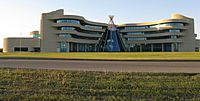
Here are some of the many projects Douglas Cardinal has completed:
- St. Mary's Church (1968) Red Deer, Alberta
- Diamond Jenness Secondary School (1972) Hay River, Northwest Territories
- Fairview Elementary School (1975) Red Deer, Alberta
- Alberta Government Services (Provincial) Building (1976) Ponoka, Alberta
- Grande Prairie Regional College (1976) Grande Prairie, Alberta
- Precam Elementary School (1976) La Ronge, Saskatchewan
- St. Albert Place & City Hall (1976) St. Albert, Alberta
- Grotski Residence (1978) Edmonton, Alberta
- Spruce Grove City Hall (1981) in Spruce Grove, Alberta
- Spruce Grove Composite High School (1982) Spruce Grove, Alberta
- Cardinal Residence (1982) Stony Plain, Alberta
- Edmonton Space And Science Centre (1984) Coronation Park, Edmonton, Alberta, now called the Telus World of Science
- Leighton Artist Colony, at the Banff Centre (1985) Banff, Alberta
- Sioux Valley (1986) Sioux Valley, Manitoba
- Canadian Museum of History (1989) in Gatineau, Quebec, across from Parliament Hill
- Jehovah's Witnesses Kingdom Hall (1991) Gatineau, Quebec
- York Region Administrative Centre (1992) in Newmarket, Ontario
- Kainai Middle School (1996) Sioux Valley, Manitoba
- National Museum of the American Indian (1993–1998) Washington
- Circle of Life Thunderbird Place (2001) Winnipeg, Manitoba
- First Nations University (2003) in Regina, Saskatchewan
- Me-No-Ya Win Health Centre (2010) Sioux lookout, Ontario
- Wabano Centre (2013) Ottawa, Ontario
- Gordon Oakes Red Bear Centre (2016) at the University of Saskatchewan in Saskatoon, Saskatchewan
- Unceded: Voices of the Land Exhibition (2018) at the Venice Biennale
- Adelante Healthcare Goodyear Project (2018) Mesa, Arizona
- Long Point First Nation, Winneway, Quebec
- Iskotew Healing Lodge, Ottawa, Ontario
- Bonneville Rehabilitation Centre, Bonnyville, Alberta
- Ojigkwanong Students Centre, Carleton University, Ottawa, Ontario
- Ile a la Crosse Elementary School, Île-à-la-Crosse, Saskatchewan
- Cardinal Studio Sudbury, Ontario
- Oujé-Bougoumou Village, Oujé-Bougoumou, Quebec
- Janvier Gallery, Cold Lake, Alberta
- Grand Traverse Civic Centre, Grand Traverse County, Michigan, USA
Achievements and Awards
Writings
Douglas Cardinal has also written books:
- Of the Spirit, published in 1977.
- The Architecture of Douglas Cardinal, written with Trevor Boddy, published in 1989.
- The Native Creative Process, written with Jeanette C. Armstrong, published in 1994.
Awards
In 2005, Cardinal received The Distinguished Artist Award from the Lieutenant Governor of Alberta. He was honored for "creating an indigenous style of Canadian architecture, characterized by gracious organic forms, which continually challenged the most advanced engineering standards."
Here are some of his other awards:
- Honor award, Alberta Association of Architects, 1968
- Award of Excellence, Canadian Architect, 1972
- Member, Royal Canadian Academy of Arts, 1974
- Fellow, Royal Architectural Institute of Canada, 1983
- Canada Council Molson Prize for the Arts, 1993
- Aboriginal Achievement Award, 1995
- RAIC Gold Medal for Architectural Achievement, 1999
- Governor General’s Award in Visual and Media Arts, 2001
- United Nations Award for Sustainable Design for Oujé-Bougoumou Village, Quebec, 2002
- Golden Jubilee Medal in honor of Her Majesty The Queen’s 50th Anniversary, 2002
- "Douglas J. Cardinal Performing Arts Centre" opened in Grand Prairie, Alberta, 2004
- Canada Post postage stamp featuring Douglas Cardinal and St. Mary's Church, 2007
- "World Master of Contemporary Architecture" by the IAA, 2006
- Gold Medal of the Union of Architects of Russia, 2009
- RAIC-NSAA Le Prix du XXe siècle for Grand Prairie Regional College, 2013
Douglas Cardinal's Family Life
Douglas Cardinal has a family with eight children. After returning to Red Deer, he met his high school friend Deirdre again. Her family did not approve of their relationship because of his background. So, they got married secretly. They had one daughter.
At that time, marriages between people from different backgrounds were not allowed in some places. Cardinal faced legal issues because of this. A lawyer and archbishop named Anthony Jordan defended Cardinal, and he was found not guilty. However, Deirdre's family encouraged her to move home, and she raised their daughter on her own.
Before moving to the United States, Cardinal started a relationship with Carole Olson. She traveled with him to Texas in 1957, where they later married. They had three children: Nancy, Guy, and Bret. They later separated.
He married Marylin Zahar in 1973. They had two children, Lisa and Jean-Marc.
His fourth wife, Idoia Arana-Beobide, is from Basque country. They met in 1988 when Cardinal was working on the Canadian Museum of History. At that time, she was a tour guide at the museum and a student. Cardinal and Arana-Beobide have two children, Aritz and Lorea. They live in Ottawa. Arana-Beobide works as a director at his architecture firm.


